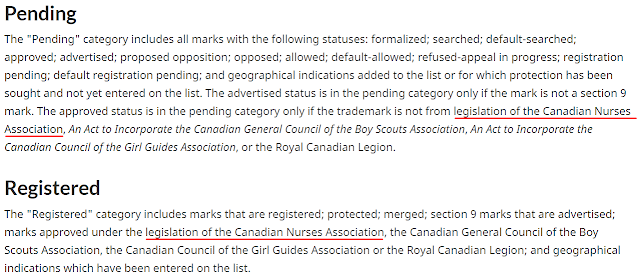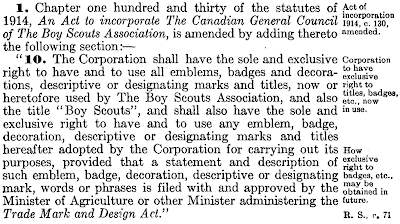CIPO’s “Mark Protected by Federal Act of Incorporation” category
The Help file associated with the Canadian Intellectual Property Office’s online trademark database contains a section headed The various categories of marks. One such category (as of 22-Mar-2021) is Mark Protected by Federal Act of Incorporation as shown in the Help file extract below:
The reference to an Act to Incorporate the Canadian Nurses Association appears to be an anachronism that should be removed from the Help file.
References to “legislation of the Canadian Nurses Association” also appear in the Pending and Registered sub-sections of the Help file’s “Trademark status” section:
I’ll begin by clarifying what this is not about. As of 22-Mar-2021 The Canadian Nurses Association/Association des infirmières et Infirmiers de Canada was the recorded owner of 101 active marks, consisting of 29 trademarks, 50 certification marks and 22 Prohibited/Official (i.e. Section 9) marks1. I am not referring to those 101 marks. I am referring only to the “Mark Protected by Federal Act of Incorporation” category. As of 22-Mar-2021, no such marks—active or inactive—owned by The Canadian Nurses Association exist in CIPO’s online trademark database or in its trademark .xml data. That is the point of this post.
Rights of exclusivity in marks are normally conferred pursuant to the Trademarks Act, RSC 1985 c. T-13. In contrast, the “Mark Protected by Federal Act of Incorporation” category pertains to the somewhat rare situation in which (1) the mark owner is itself incorporated pursuant to a federal statute and (2) that same statute confers a right of exclusivity in the mark. For example, Section 1 of An Act to Incorporate The Canadian Council of The Girl Guides Association, (1917) 7-8 George V, c. 77 incorporates that Association; and Section 10 of the same statute provides (click to enlarge the image):
Similarly, Section 1 of An Act to Incorporate The Canadian Council of The Boy Scouts Association, (1914) 4-5 George V, c. 130 incorporates that Association. However, possibly due to legislative oversight, the original Boy Scouts’ incorporating statute contained no equivalent to Section 10 of the Girl Guides’ statute. That was remedied by An Act to Amend An Act to Incorporate The Canadian Council of The Boy Scouts Association, (1917) 7-8 George V, c. 73, which provides:
Exactly which Federal Acts of incorporation are encompassed by the “Mark Protected by Federal Act of Incorporation” category? CIPO does not expose them separately via the online database user interface, but they can be exposed by cross-querying the <catmk:TrademarkClassCode> and <catmk:LegislationCode> elements of CIPO’s trademark .xml data. Appendix L of CIPO’s Trademarks Data Dictionary explains that the <catmk:TrademarkClassCode> value 17 corresponds to the “Mark Protected by Federal Act of Incorporation” category. Cross-querying that value of that element against the <catmk:LegislationCode> element for all of the 1,773,357 marks represented in CIPO’s trademark .xml data as of 22-Mar-2021 yields only two distinct values—6 and 7—for the <catmk:LegislationCode> element. The Data Dictionary reveals that those two values respectively correspond to the aforementioned Boy Scouts / Girl Guides statutes (click to enlarge the image):
The Boy Scouts / Girl Guides statutes are the only 2 statutes that come within the “Mark Protected by Federal Act of Incorporation” category for the entirety of the 1,773,357 marks represented in CIPO’s trademark .xml data (i.e. the entire Canadian trademarks register) as of 22-Mar-2021.
More particularly, no “nursing” statutes currently come within the “Mark Protected by Federal Act of Incorporation” category. As of 22-Mar-2021 that category contained 293 active marks: 121 Boy Scout marks and 172 Girl Guide marks—including many emblems, badges, decorations, etc.; some of which may have appeared on your Boy Scout / Girl Guide uniform over half a century ago.
So what is going on? Why does the Help file refer to an Act to Incorporate the Canadian Nurses Association and to “legislation of the Canadian Nurses Association”? The answer, I believe, is that these are obsolete references to An Act to incorporate Canadian Nurses’ Association, (1947) 11 George VI, c. 88. Section 15 of that statute provides (click to enlarge the image):
Section 10 in each of the aforementioned Boy Scouts / Girl Guides statutes provides for filing with and approval by the Minister administering the Trade Mark and Design Act [(1868) 31 Vict., c. 55; RSC 1906 c. 71] of a statement and description of the mark. Such “approval” is the final step in confirming protection for a mark in the “Mark Protected by Federal Act of Incorporation” category2. That is how 113 Boy Scout marks found their way—in 1920—onto the trademarks register kept under the Trade Mark and Design Act. Section 23(1) of the Unfair Competition Act, (1932) 22-23 George V, c. 38 (which was in force until June 1954) provided “The register now existing under the Trade Mark and Design Act shall form part of the register maintained pursuant to this Act”; thus carrying those Boy Scout marks over onto the trademarks register kept under the Unfair Competition Act. Section 27(1) of the current Trademarks Act, RSC 1985 c. T-13 provides that the register kept under the Unfair Competition Act forms part of the register kept under the current statute, thus further carrying those Boy Scout marks over onto the current trademarks register, together with 162 Girl Guide marks which first appeared on the register in 1935.
A few more Boy Scout / Girl Guide marks followed in subsequent years, making up the aforementioned total of 293 active marks which remain on the register in the “Mark Protected by Federal Act of Incorporation” category. Unlike ordinary registered trademarks, marks in the “Mark Protected by Federal Act of Incorporation” category are not subject to renewal and may theoretically remain on the register in perpetuity.
Any marks of the Canadian Nurses Association that may have been “approved” pursuant to Section 15 of (1947) 11 George VI, c. 88 and the Unfair Competition Act would likewise have been carried over onto the current register3 and categorized by CIPO as “Mark Protected by Federal Act of Incorporation”. But there are none.
As explained in the Data Dictionary, CIPO has created “certain special application number ranges” including the 0980nnn range which is reserved for “Boy Scouts, Girl Guides, and Royal Canadian Legion” marks4. Why is there no reference to nursing marks? Because there is no need for such a reference. Even if the Canadian Nurses Association did record one or more marks pursuant to Section 15 of (1947) 11 George VI, c. 88, any such marks appear to have been cancelled or withdrawn before the cutoff date as of which CIPO’s electronic trademark records were created5. As stated in the Data Dictionary “The information base does not contain all trademarks which were cancelled or expunged prior to 1979 or applications abandoned or refused prior to 1980.”
If the Help file is to retain references to the Canadian Nurses Association, then it may as well also include references to The Association of Canadian Clubs and The Association of Kinsmen Clubs, having regard to An Act to incorporate The Association of Canadian Clubs, (1939) 3 George VI, c. 61; and An Act to incorporate The Association of Kinsmen Clubs, (1950) 14 George VI, c. 64. As shown below (click to enlarge the image), Sections 12 and 10 of those statutes are respectively substantially identical to section 15 of An Act to incorporate Canadian Nurses' Association, (1947) 11 George VI, c. 88 as reproduced above.
However, neither the online database nor CIPO’s trademark .xml data contain any marks recorded pursuant to either An Act to incorporate The Association of Canadian Clubs or An Act to incorporate The Association of Kinsmen Clubs—just as there are no marks recorded pursuant to An Act to incorporate Canadian Nurses’ Association.
You may be thinking “Who cares about those old Boy Scout / Girl Guide statutes from the time of King George V? They are ancient history and probably became irrelevant before WWII.” Not so! As recently as 30-May-2018 Girl Guides of Canada - Guides du Canada filed 4 applications6 to protect various marks which CIPO has approved and categorized “Mark Protected by Federal Act of Incorporation” as shown in the example on the right (click to enlarge the image).
But wait—if the Girl Guides can still utilize the “Mark Protected by Federal Act of Incorporation” category over a century after their incorporation, can’t the Canadian Nurses Association do the same? Perhaps not. According to its Bylaws, “The Canadian Nurses Association (CNA) is an association continued under the Canada Not-For-Profit Corporations Act S.C. 2009, c.23 as a not-for-profit organization”. This suggests that the association may no longer be subject to a Federal Act of Incorporation containing a provision conferring mark exclusivity as set forth in Section 15 of (1947) 11 George VI, c. 88. If that is correct then the Canadian Nurses Association, in its present form, would appear to be excluded from the “Mark Protected by Federal Act of Incorporation” category.
1 If you check this by searching CIPO’s online trademark database you’ll get 78 hits—not 28—if you restrict the search Category to Trademarks via the database’s Additional Search Options feature. That’s because CIPO includes certification marks in the Trademarks Category in addition to breaking them out separately via the Certification Marks Category. This is explained in my Mark Categories & Classes post.↩
2 In contrast, Trademarks are “registered”, Prohibited/Official Marks are “advertised” in the Trademarks Journal, Geographical Indications are “entered on the list”, Plant Breeder's Rights Denominations are “granted”.↩
3 Also see Section 54(4) of the current statute, which provides for the admissibility in evidence of “A copy of any entry made or documents filed under the authority of any Act in force before July 1, 1954 relating to trademarks...”↩
4 CIPO has a separate category “Mark Protected by an Act Respecting the Royal Canadian Legion” for the Royal Canadian Legion’s marks, having regard to An Act to incorporate The Canadian Legion of the British Empire Service League, (1948) 11-12 George VI, c. 84; as amended by An Act respecting The Canadian Legion of the British Empire Service League, (1951) 15 George VI, c. 86. Briefly, third party use of the Legion’s marks is prohibited “...Provided that a statement or description of such [mark] is filed with and approved by...the...Minister administering the Unfair
Competition Act, 1932, or any legislation subsequently enacted or substituted therefor.” That prohibition differs from the rights of exclusivity conferred by the Boy Scouts / Girl Guides statutes, necessitating separate categorization of the Legion’s marks. Only 6 marks remain on the register in CIPO’s “Mark protected by an Act Respecting the Royal Canadian Legion” category.↩
5 In its 17 June 2019 “Electronic register” Practice Notice, CIPO states “The official version of [the] register [kept under the Trademarks Act, RSC 1985 c. T-13] is the one kept by the Registrar in electronic form. The version of the Register that is kept in paper form is not the official version but will remain available for consultation...”↩









